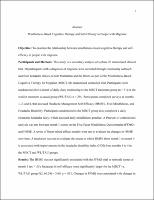Please use this identifier to cite or link to this item:
https://hdl.handle.net/20.500.12202/6656| Title: | Mindfulness-Based Cognitive Therapy and Self-Efficacy in People with Migraine. |
| Authors: | Seng, Elizabeth K. Feldman, Jonathan Hirky, Anne Elizabeth Weinberger, Andrea Swencionis, Charles Butler, Nicole |
| Keywords: | Psychology Health Care Management Mindfulness-Based Cognitive Therapy Self-Efficacy Migraine |
| Issue Date: | Aug-2020 |
| Citation: | Butler, Nicole. (2020). Mindfulness-Based Cognitive Therapy and Self-Efficacy in People with Migraine. (Publication No. 28321078). [Doctoral Dissertation, Yeshiva University] ProQuest. |
| Abstract: | Objective: To examine the relationship between mindfulness-based cognitive therapy and self-efficacy in people with migraine. Participants and Methods: This study is a secondary analysis of a phase 2b randomized clinical trial. 60 participants with a diagnosis of migraine were recruited through community outreach and from headache clinics in both Manhattan and the Bronx as part of the Mindfulness-Based Cognitive Therapy for Migraine (MBCT-M) randomized controlled trial. Participants were randomized after a month of daily diary monitoring to the MBCT treatment group (n = 31) or the waitlist treatment as usual group (WL/TAU; n = 29). Participants completed surveys at months 1, 2, and 4, that assessed Headache Management Self-Efficacy (HMSE), Trait Mindfulness, and Headache Disability. Participants randomized to the MBCT group also completed a daily electronic headache diary, which assessed daily mindfulness practice. A Pearson’s r correlational analysis was run between month 1 scores on the Five-Facet Mindfulness Questionnaire (FFMQ) and HMSE. A series of linear mixed effects models were run to evaluate the changes in HMSE over time. A mediation was run to evaluate the extent to which HMSE from month 1 to month 4 is associated with improvements in the headache disability index (HDI) from months 1 to 4 in the MBCT and WL/TAU groups. Results: The HMSE was not significantly associated with the FFMQ total or subscale scores at month 1 (ps > .05). Increases in self-efficacy were significantly larger for the MBCT vs. WL/TAU group F(2, 60.58) = 3.69, p = .031. Changes in FFMQ were associated with changes in HMSE (F(1, 48.27) = 5.01, p = .030) although this did not differ by treatment group (F(2, 59.104) = .423, p = .657). Within the MBCT group (n = 31), both month F(2, 53.79) = 3.69, p = .032 and proportion of days meditated F(1, 35.93) = 6.35, p = .016 were associated with higher HMSE. Among MBCT completers (n = 25), changes in self-efficacy mediated changes in disability at month 4 compared to month 1 (indirect effect B = -6.96, 95% CI = 2.19, 13.72). Comparatively, within the WL/TAU group (n = 26) the indirect effect of the completers analysis revealed that HMSE did not significantly mediate changes in disability (indirect effect B 1.02 95% CI = -4.01, 0.98. Conclusions: Participation in the MBCT-M intervention may significantly improve headache management self-efficacy over time within people with migraine. Additionally, self-efficacy mediated changes in time on disability, which is the primary outcome of the parent study. These findings provide strong preliminary evidence that self-efficacy may be an important change mechanism for mindfulness-based treatments for migraine. |
| Description: | Doctoral Dissertation / Open Access |
| URI: | https://hdl.handle.net/20.500.12202/6656 |
| Appears in Collections: | Ferkauf Graduate School of Psychology: Doctoral Dissertations |
Files in This Item:
| File | Description | Size | Format | |
|---|---|---|---|---|
| Butler Nicole Dissertation Document Final 9.15.20.pdf | 581.23 kB | Adobe PDF |  View/Open |
This item is licensed under a Creative Commons License

